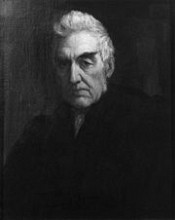Milman Henry Hart

The Very Reverend Henry Hart Milman (10 February 1791 - 24 September 1868[1]) was an English historian and ecclesiastic. He was born in London, the third son of Sir Francis Milman, 1st Baronet, physician to King George III (see Milman Baronets). Educated at Eton and at Brasenose College, Oxford, his university career was brilliant. He won the Newdigate prize with a poem on the Apollo Belvidere in 1812, was elected a fellow of Brasenose in 1814, and in 1816 won the English essay prize with his Comparative Estimate of Sculpture and Painting. In 1816 he was ordained, and two years later became parish priest of St Mary's, Reading. Milman had already made his appearance as a dramatist with his tragedy Fazio (produced on the stage under the title of The Italian Wife). He also wrote Samor, the Lord of The Bright City, the subject of which was taken from British legend, the "bright city" being Gloucester. In subsequent poetical works he was more successful, notably the Fall of Jerusalem (1820) and The Martyr of Antioch (1822, based on the life of Saint Margaret the Virgin), which was used as the basis for an oratorio by Arthur Sullivan. The influence of Byron is seen in his Belshazzar (1822). Another tragedy, Anne Boleyn, followed in 1826. Milman also wrote "When our-heads are bowed with woe," and other hymns; an admirable version of the Sanskrit episode of Nala and Damayanti; and translations of the Agamemnon of Aeschylus and the Bacchae of Euripides. In 1821 he was elected professor of poetry at Oxford, and in 1827 he delivered the Bampton lectures on the character and conduct of the apostles as an evidence of Christianity. His poetical works were published in three volumes in 1839. Turning to another field, Milman published in 1829 his History of the Jews, which is memorable as the first by an English clergyman which treated the Jews as an Oriental tribe, recognized sheikhs and amirs in the Old Testament, sifted and classified documentary evidence, and evaded or minimized the miraculous. In consequence, the author was violently attacked and his inevitable preferment was delayed. In 1835, however, Sir Robert Peel made him rector of St Margaret's, Westminster, and canon of Westminster, and in 1849 he became dean of St Paul's. By this time he had achieved popularity and occupied a dignified and enviable position. His History of Christianity to the Abolition of Paganism in the Roman Empire (1840) had been completely ignored; but the continuation of his work, his great History of Latin Christianity (1855), which has passed through many editions, was well received. In 1838 he had edited Edward Gibbon's Decline and Fall of the Roman Empire, and in the following year published his Life of Gibbon. Milman was also responsible for an edition of Horace, and when he died he had almost finished a history of St Paul's Cathedral, which was completed and published by his son, A Milman (London, 1868), who also collected and published in 1879 a volume of his essays and articles. Milman was buried in St Paul's Cathedral. By his wife, Mary Ann, a daughter of Lieut.-General William Cockell, he had four sons and two daughters. His nephew, Robert Milman (1816-1876), was Bishop of Calcutta from 1867 until his death, and was the author of a Life of Torquato Tasso (1850).
do you like this author?
What readers are saying
What do you think? Write your own comment on this book!
write a commentWhat readers are saying
What do you think? Write your own comment on this author!
write a commentBook list

Nala and Damayanti and Other Poems
Series:
Unknown
Year:
Unknown
Raiting:
4/5
This scarce antiquarian book is included in our special Legacy Reprint Series. In the interest of creating a more extensive selection of rare historical book reprints, we have chosen to reproduce this title even though it may possibly have occasional imperfections such as missing and blurred pages, missing text, poor pictures, markings, dark backgrounds and other reproduction issues beyond our control. Because this work is culturally important, we have made it available as a part of our commitment to protecting, preserving and promoting the world's literature. --This text refers to an alternate Paperback edition.
Show more
add to favoritesadd In favorites
Book list

Nala and Damayanti and Other Poems
Series:
Unknown
Year:
Unknown
Raiting:
4/5
This scarce antiquarian book is included in our special Legacy Reprint Series. In the interest of creating a more extensive selection of rare historical book reprints, we have chosen to reproduce this title even though it may possibly have occasional imperfections such as missing and blurred pages, missing text, poor pictures, markings, dark backgrounds and other reproduction issues beyond our control. Because this work is culturally important, we have made it available as a part of our commitment to protecting, preserving and promoting the world's literature. --This text refers to an alternate Paperback edition.
Show more
add to favoritesadd In favorites
What readers are saying
What do you think? Write your own comment on this author!
write a commentif you like Milman Henry Hart try:
readers also enjoyed
What readers are saying
What do you think? Write your own comment on this author!
write a commentif you like Milman Henry Hart try:
readers also enjoyed
Do you want to exchange books? It’s EASY!
Get registered and find other users who want to give their favourite books to good hands!

